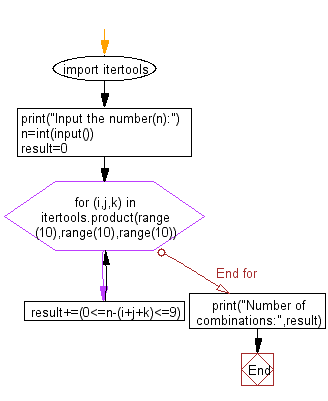Python: Find the number of combinations of a,b,c and d
Sum Combinations Counter
Write a Python program that reads an integer n and finds the number of combinations of a,b,c and d (0 = a,b,c,d = 9) where (a + b + c + d) will be equal to n.
Input:
n (1 ≤ n ≤ 50)
Input the number(n): 15
Number of combinations: 592
Sample Solution:
Python Code:
# Import the itertools module to work with iterators and combinatorial functions
import itertools
# Prompt the user to input a number 'n'
print("Input the number(n):")
# Read the user input and convert it to an integer
n = int(input())
# Initialize the variable 'result' to store the count of combinations
result = 0
# Iterate over all combinations of (i, j, k) where i, j, k are in the range [0, 9]
for (i, j, k) in itertools.product(range(10), range(10), range(10)):
# Check if the sum of i, j, and k lies between 0 and 9 (inclusive)
result += (0 <= n - (i + j + k) <= 9)
# Print the number of combinations that satisfy the condition
print("Number of combinations:", result)
Sample Output:
Input the number(n): 15 Number of combinations: 592
Explanation:
The above Python code prompts the user to input a number 'n' and then counts the number of combinations of three digits (i, j, k), where each digit ranges from 0 to 9, such that their sum is equal to 'n'. The code utilizes the itertools module to generate all possible combinations of (i, j, k) and increments a counter 'result' whenever the sum of these digits falls between 0 and 9 (inclusive).
Finally, it prints the count of combinations that satisfy the given condition.
Flowchart:

For more Practice: Solve these Related Problems:
- Write a Python program to count the number of combinations of four digits whose product equals a given number.
- Write a Python program to count the number of unique combinations of four digits that sum to a given target where no digit repeats.
- Write a Python program to count the number of ways a subset of numbers from a list can sum up to a target value.
- Write a Python program to compute the number of combinations of four non-negative integers that sum to a given number using dynamic programming.
Go to:
Previous: Write a Python program to compute the amount of the debt in n months. The borrowing amount is $100,000 and the loan adds 5% interest of the debt and rounds it to the nearest 1,000 above month by month.
Next: Write a Python program to print the number of prime numbers which are less than or equal to an given integer.
Python Code Editor:
Have another way to solve this solution? Contribute your code (and comments) through Disqus.
What is the difficulty level of this exercise?
Test your Programming skills with w3resource's quiz.
